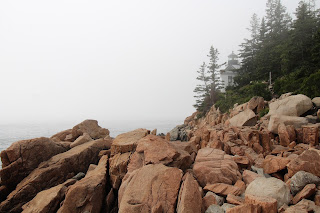Most of the “main attractions” at Acadia – Sand Beach, Cadillac Mountain, Thunder Hole, Jordan Pond – are located on the east side of Mount Desert Island (MDI). However, after
cross stitching the Bass Harbor Head Light, I had to go see it in person, and the Bass Harbor lighthouse is on the west side of MDI. While looking through the guidebook for potential hikes I also found some trails on the west side, so we decided to spend a day over on that half of the island and see what it had to offer.
We started out the day summitting the 681 ft. Acadia Mountain for views of Sommes Sound, the fjord that splits MDI into its two halves. The hiking was similar to what hiking in the northeast can often be like – wooded dirt paths on the flat, then a lot of rocks and stone steps when you’re climbing, often transitioning to bare rock at higher elevation. It was a relatively quick, if rocky, 0.7 miles to the summit, so
I convinced everyone we opted to continue along the trail and loop back to the parking area instead of backtracking. The trail continues toward the sound for another quarter mile, giving more views of the fjord before descending into the forest down to Man of War Brook. From there, you can connect to the Valley Cove Trail that follows the shoreline of the sound (when it’s not closed for peregrine falcon nesting) or the Valley Peak Trail that leads up to St. Sauveur Mountain, but we took the Man o’ War Truck Road back out to where we had parked for a total loop distance of about 2.8 miles.
 |
| Sommes Sound |
The guidebook also praised the views of Sommes Sound from Flying Mountain, so we headed there next. This was another quick hike, just 0.3 miles to the 284 ft. summit. The views were nice, especially for a spot that can be reached in ten minutes, but somewhat similar to those from Acadia Mountain. Flying Mountain is further south, and it’s lower in elevation, so you do get a closer look at the area around the sound and the view out to the ocean.
 |
| View from Flying Mountain |
From Flying Mountain, we continued onward in the direction of the Bass Harbor Lighthouse, making two more stops along the way. The first was the natural Seawall, featuring lots of rocks and ocean waves. It’s apparently a good spot to watch the sunrise over Great Cranberry Island or stargaze, but we just stopped by to enjoy the rocks and waves before heading on our way.
 |
| Seawall |
Our second stop was Wonderland. With a name like Wonderland, how could we not stop? We made the (fortunately not serious) mistake of not actually checking how long the trail was (it looked short on the map and was wide and flat) and it turned out to be longer than it looked (0.7 miles one way), but it was fine. Wonderland is one of the main spots known for tide pools at low tide, but as usual we weren’t scheduling anything by the tides and we were there at the wrong time, though there were still a couple pools. I managed to see a few small fish, a couple snails clinging to the rocks, and a mini crab or two.
 |
| Wonderland |
Finally, we made it to the destination that was the original reason for visiting this half of MDI, the Bass Harbor Head Light, just in time for the fog to roll in again. Yes, really. During the summer, the sun sets behind the lighthouse, which can produce some very nice photos, assuming the sun is actually visible. Which it was most definitely not on this day. Still, I got to see the lighthouse, and earlier in the day enjoy tide pools and a fjord, so I’m not complaining. Too much.
 |
| Bass Harbor Head Light |